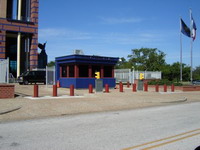Federal Reserve predicts slower US economic growth and unemployment
The Federal Reserve expects slower U.S. economic growth and a slight unemployment next year due to the housing slump and a credit crunch.

The fresh assessment of America's future economic performance was issued by the Fed in the first of its quarterly reports to the nation.
On the growth side, the Fed said it believes that business growth will slow next year, with the gross domestic product (GDP) coming in between 1.8 percent and 2.5 percent. That would be weaker than how the Fed expects the economy to perform this year and would mark a downgrade to a previous projection released in the summer.
The downgrade was due to a number of factors, including "the tightened terms and reduced availability of subprime and jumbo mortgages, weaker-than-expected housing data and rising oil prices," the Fed explained.
The credit crunch has both made it more costly and more difficult for people and companies to borrow money. The worst carnage has taken place in the market for "subprime" home loans - those made to people with spotty credit histories. Credit problems started there and have spread to more creditworthy borrowers including those that are looking for home loans of more than $417,000 (282,043 EUR), so-called jumbo loans.
The overriding worry is that these housing and credit problems will make people less inclined to spend, putting a damper on economic growth.
That concern is on the Fed's radar, too.
"Partly in response to declining housing wealth, the personal savings rate was expected to rise over the next few years, contributing to restraint" on the growth of consumer spending, the Fed said as it provided more details about its projection for slower GDP growth in 2008.
GDP is the value of all goods and services produced within the United States and is the best barometer of the country's economic fitness.
The unemployment rate would rise to between 4.8 percent and 4.9 percent next year - still low by historical standards. A previous forecast estimated the unemployment rate next year would be about 4.75 percent. The unemployment rate currently stands at 4.7 percent. For all of last year, it dipped to 4.6 percent, a six-year low.
With economic growth slowing, "the unemployment rate would increase modestly" in 2008, stabilize in 2009 and then decline slightly in 2010, the Fed said.
Overall inflation should ebb next year to between a 1.8 percent and 2.1 percent increase. Inflation should moderate further in 2009 and 2010, the Fed said.
"Overall inflation was expected to edge down over the next few years, fostered by an assumed flattening of energy prices," the Fed said.
So far, surging energy prices this year haven't touched off a major inflation problem.
Oil prices last week hit a record high of $98.62 a barrel. They have ebbed a bit and are hovering over $96 a barrel. Gasoline prices have topped $3 a gallon (80 cents a liter).
The Fed's forecasts are based on estimates of activity in the final quarter of one year compared with the same period of a previous year.
Tuesday's forecast was a fulfillment of Federal Reserve Chairman Ben Bernanke's pledge to bring more openness to an institution that historically has been enshrouded in secrecy.
It marked the biggest move yet by Bernanke to put his imprint on the Fed, which he has been running since February 2006.
Alan Greenspan, Bernanke's predecessor - made progress on that front in his 18 1/2 years, but Bernanke has sought to pry the door open even further, providing investors, businesses and individuals with more insights into the thinking of Fed policymakers.
Doing that helps the Fed do its job - keeping the economy and inflation on an even keel.
Improving the public's understanding of the Fed's objectives and strategies reduces uncertainty, allowing businesses and people to make more informed financial decisions. If investors have a better understanding of how Fed policy is likely to respond to incoming information, stock prices and bond yields will tend to respond to economic data in ways that further the central bank's objectives.
A research paper released Tuesday by Fed drove home the point that forecasting is as much an art as it is a science.
"If past performance is a reasonable guide to the accuracy of future forecasts, considerable uncertainty surrounds all macroeconomic projections" - including those of Fed policymakers - the paper said.
Bernanke last week announced steps to bring greater openness to the institution that historically has substantially operated behind closed doors. With Tuesday's report, the Fed is now releasing quarterly economic forecasts, versus twice-a-year projections. The Fed is also saying what it thinks the business environment will be for the following three years- not two. The Fed also is giving unprecedented detail into what the thinking of the policymakers is about how they expect the economy to perform and the risks facing it.
Subscribe to Pravda.Ru Telegram channel, Facebook, RSS!


